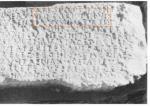02-19-2017, 10:12 PM
(This post was last modified: 02-19-2017, 10:46 PM by Nathan Ross.)
I've been having another look at inscription AE 1977, 00806, from Nakolea - the tombstone of a soldier called Flavius Aemilianus, who apparently served as ducenarius in the numerus ioviorum cornutorum seniorum.
The only survey of the inscription I can find is 'A Fourth-Century Latin Soldier's Epitaph at Nakolea' by Thomas Drew-Bear (Harvard Studies in Classical Philology Vol. 81 (1977), pp. 257-274). Drew-Bear provides the following rendering of the text:

The consular dating at the end is specific to AD356. Aemilianus served 27 years, and so must have enlisted in AD329. The inscription says he was born in 'Dacia' (apparently the diocese of Dacia is meant), at the city of Flavia Singidunum. This would presumably make him a Roman citizen, which conflicts with the general idea that the auxilia units were raised from barbarians.
What interests me in this case is the name of the unit. There is no Numerus Ioviorum Cornutorum Seniorum (or Iovii Cornuti Seniores) listed in the Notitia Dignitatum, although there are auxilia units called Iovii and Cornuti Seniores. One possible option might be that this unit was destroyed or disappeared prior to the ND's compilation. Or, perhaps, that this extra title was for some reason never mentioned anywhere else... But could the reading of the inscription be wrong?
Here's the part of the stone that mentions the unit (from Drew-Bear) - it's a bad photo, but I've highlighted what I take to be the unit name:

1. Might the text refer to two separate units? First the Numerus Ioviorum (ie the ND's Iovii) and then the (Numerus) Cornutorum Seniorum? Aemilianus could have served first in one and then the other... Although in the ND the Iovii are also Seniores, so surely that would be mentioned here?
2. Might the letters that Drew-Bear and others read as I O actual be E Q? That would make the unit the Numerus Equitum Cornutorum Seniorum - in other words, the Equites Cornuti Seniores of the ND. The tombstones from Concordia have other auxilia numeri equitum written this way. Could Aemilianus actually have been a cavalry trooper?
Any thoughts much appreciated!
The only survey of the inscription I can find is 'A Fourth-Century Latin Soldier's Epitaph at Nakolea' by Thomas Drew-Bear (Harvard Studies in Classical Philology Vol. 81 (1977), pp. 257-274). Drew-Bear provides the following rendering of the text:
The consular dating at the end is specific to AD356. Aemilianus served 27 years, and so must have enlisted in AD329. The inscription says he was born in 'Dacia' (apparently the diocese of Dacia is meant), at the city of Flavia Singidunum. This would presumably make him a Roman citizen, which conflicts with the general idea that the auxilia units were raised from barbarians.
What interests me in this case is the name of the unit. There is no Numerus Ioviorum Cornutorum Seniorum (or Iovii Cornuti Seniores) listed in the Notitia Dignitatum, although there are auxilia units called Iovii and Cornuti Seniores. One possible option might be that this unit was destroyed or disappeared prior to the ND's compilation. Or, perhaps, that this extra title was for some reason never mentioned anywhere else... But could the reading of the inscription be wrong?
Here's the part of the stone that mentions the unit (from Drew-Bear) - it's a bad photo, but I've highlighted what I take to be the unit name:
1. Might the text refer to two separate units? First the Numerus Ioviorum (ie the ND's Iovii) and then the (Numerus) Cornutorum Seniorum? Aemilianus could have served first in one and then the other... Although in the ND the Iovii are also Seniores, so surely that would be mentioned here?
2. Might the letters that Drew-Bear and others read as I O actual be E Q? That would make the unit the Numerus Equitum Cornutorum Seniorum - in other words, the Equites Cornuti Seniores of the ND. The tombstones from Concordia have other auxilia numeri equitum written this way. Could Aemilianus actually have been a cavalry trooper?
Any thoughts much appreciated!
Nathan Ross







